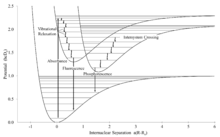Intersystem crossing
Intersystem crossing is a radiationless process involving a transition between two electronic states with different spin multiplicity.[1]

Singlet and triplet states
When an electron in a molecule with a singlet ground state is excited (via absorption of radiation) to a higher energy level, either an excited singlet state or an excited triplet state will form. A singlet state is a molecular electronic state such that all electron spins are paired. That is, the spin of the excited electron is still paired with the ground state electron (a pair of electrons in the same energy level must have opposite spins, per the Pauli exclusion principle). In a triplet state the excited electron is no longer paired with the ground state electron; that is, they are parallel (same spin). Since excitation to a triplet state involves an additional "forbidden" spin transition, it is less probable that a triplet state will form when the molecule absorbs radiation.

When a singlet state nonradiatively passes to a triplet state, or conversely a triplet transitions to a singlet, that process is known as intersystem crossing. In essence, the spin of the excited electron is reversed. The probability of this process occurring is more favorable when the vibrational levels of the two excited states overlap, since little or no energy must be gained or lost in the transition. As the spin/orbital interactions in such molecules are substantial and a change in spin is thus more favourable, intersystem crossing is most common in heavy-atom molecules (e.g. those containing iodine or bromine). This process is called "spin-orbit coupling". Simply-stated, it involves coupling of the electron spin with the orbital angular momentum of non-circular orbits. In addition, the presence of paramagnetic species in solution enhances intersystem crossing.[2]
The radiative decay from an excited triplet state back to a singlet state is known as phosphorescence. Since a transition in spin multiplicity is observed, phosphorescence is another manifestation of intersystem crossing. The time scale of intersystem crossing is on the order of 10−8 to 10−3 s, one of the slowest forms of relaxation.[3]
References
- ↑ IUPAC, Compendium of Chemical Terminology, 2nd ed. (the "Gold Book") (1997). Online corrected version: (2006–) "Intersystem crossing".
- ↑ Douglas A. Skoog, F. James Holler, and Timothy A. Nieman. Principles of Instrumental Analysis, 5th Ed. Brooks/Cole, 1998.
- ↑ Donald A. McQuarrie and John D. Simon. Physical Chemistry, a Molecular Approach. University Science Books, 1997.